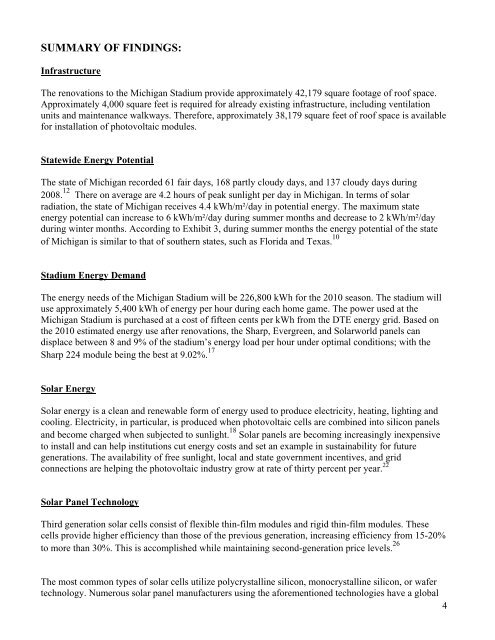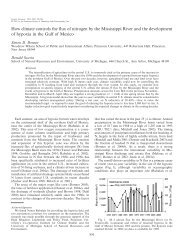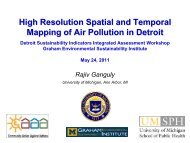2009report-solarstad.. - Graham Sustainability Institute - University ...
2009report-solarstad.. - Graham Sustainability Institute - University ...
2009report-solarstad.. - Graham Sustainability Institute - University ...
Create successful ePaper yourself
Turn your PDF publications into a flip-book with our unique Google optimized e-Paper software.
SUMMARY OF FINDINGS:InfrastructureThe renovations to the Michigan Stadium provide approximately 42,179 square footage of roof space.Approximately 4,000 square feet is required for already existing infrastructure, including ventilationunits and maintenance walkways. Therefore, approximately 38,179 square feet of roof space is availablefor installation of photovoltaic modules.Statewide Energy PotentialThe state of Michigan recorded 61 fair days, 168 partly cloudy days, and 137 cloudy days during2008. 12 There on average are 4.2 hours of peak sunlight per day in Michigan. In terms of solarradiation, the state of Michigan receives 4.4 kWh/m²/day in potential energy. The maximum stateenergy potential can increase to 6 kWh/m²/day during summer months and decrease to 2 kWh/m²/dayduring winter months. According to Exhibit 3, during summer months the energy potential of the stateof Michigan is similar to that of southern states, such as Florida and Texas. 10Stadium Energy DemandThe energy needs of the Michigan Stadium will be 226,800 kWh for the 2010 season. The stadium willuse approximately 5,400 kWh of energy per hour during each home game. The power used at theMichigan Stadium is purchased at a cost of fifteen cents per kWh from the DTE energy grid. Based onthe 2010 estimated energy use after renovations, the Sharp, Evergreen, and Solarworld panels candisplace between 8 and 9% of the stadium’s energy load per hour under optimal conditions; with theSharp 224 module being the best at 9.02%. 17Solar EnergySolar energy is a clean and renewable form of energy used to produce electricity, heating, lighting andcooling. Electricity, in particular, is produced when photovoltaic cells are combined into silicon panelsand become charged when subjected to sunlight. 18 Solar panels are becoming increasingly inexpensiveto install and can help institutions cut energy costs and set an example in sustainability for futuregenerations. The availability of free sunlight, local and state government incentives, and gridconnections are helping the photovoltaic industry grow at rate of thirty percent per year. 22Solar Panel TechnologyThird generation solar cells consist of flexible thin-film modules and rigid thin-film modules. Thesecells provide higher efficiency than those of the previous generation, increasing efficiency from 15-20%to more than 30%. This is accomplished while maintaining second-generation price levels. 26The most common types of solar cells utilize polycrystalline silicon, monocrystalline silicon, or wafertechnology. Numerous solar panel manufacturers using the aforementioned technologies have a global4










